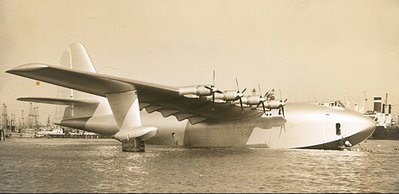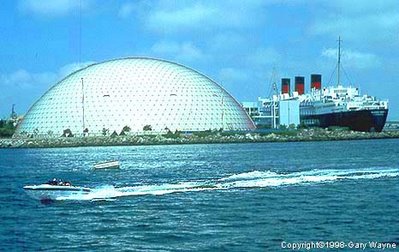 Howard Hughes (1905-1976) was born in Houston, Texas. He was a movie producer, aviator and industrialist whose legendary desire for privacy generated many rumors and much curiosity. Perhaps best remembered for designing an eight-engine flying boat, nicknamed the Spruce Goose, which was to carry 750 passengers, although it only made one brief test flight.
Howard Hughes (1905-1976) was born in Houston, Texas. He was a movie producer, aviator and industrialist whose legendary desire for privacy generated many rumors and much curiosity. Perhaps best remembered for designing an eight-engine flying boat, nicknamed the Spruce Goose, which was to carry 750 passengers, although it only made one brief test flight.The Hughes H-4 Hercules ("Spruce Goose") is an aircraft designed and built by Howard Hughes's Hughes Aircraft company. Its first and only flight was in 1947. Hughes himself detested the nickname "Spruce Goose". The nickname arose as a way of mocking the Hercules project due to Hughes' alleged misuse of government funding to build the aircraft. The Hercules is the largest flying boat, and still holds the record for the largest wingspan of any aircraft ever. Only one was ever built.
Due to wartime restrictions on the availability of metals, the H-4 was built almost entirely of laminated birch, not spruce as its nickname suggests. The aircraft was a marvel in its time. It married a soon-to-be outdated technology — flying boats — to a massive airframe that required some truly ingenious engineering innovations.
 In 1942, the U.S. Department of War was faced with the need to transport war matériel and personnel to Britain. Allied shipping in the Atlantic Ocean was suffering heavy losses to German U-boats, so a requirement was issued for an aircraft that could cross the Atlantic with a large payload.
In 1942, the U.S. Department of War was faced with the need to transport war matériel and personnel to Britain. Allied shipping in the Atlantic Ocean was suffering heavy losses to German U-boats, so a requirement was issued for an aircraft that could cross the Atlantic with a large payload.The aircraft was the brainchild of Henry J. Kaiser, who directed the Liberty ships program. He teamed with aircraft designer Howard Hughes to create what would become the largest aircraft built or even seriously contemplated at that time. When completed, it would be capable of carrying 750 fully-equipped troops or two M4 Sherman tanks.
To conserve metal for the war effort, it would be built mostly of wood: hence the Spruce Goose moniker. It was also referred to as the Flying Lumberyard by critics who believed an aircraft of its size simply could not fly.
 Development dragged on and was not completed until well after the war was over. In 1947, Howard Hughes was called to testify before the Senate War Investigating Committee over the usage of government funds for the aircraft, as Congress was eliminating war-era spending to free up Federal funds for domestic projects. Though he encountered skepticism and even hostility from the committee, Hughes remained unruffled. During a break in the hearings, he returned to California, ostensibly to run taxi tests on the H-4. On November 2, 1947, with Howard Hughes at the controls, the Hercules lifted off from the waters off Long Beach, remaining airborne 70 feet (20 m) off the water at a speed of 80 mph (130 km/h) for just under a mile (1.6 km). At this altitude the plane was still experiencing ground effect and some critics believe it lacked the power necessary to truly fly.
Development dragged on and was not completed until well after the war was over. In 1947, Howard Hughes was called to testify before the Senate War Investigating Committee over the usage of government funds for the aircraft, as Congress was eliminating war-era spending to free up Federal funds for domestic projects. Though he encountered skepticism and even hostility from the committee, Hughes remained unruffled. During a break in the hearings, he returned to California, ostensibly to run taxi tests on the H-4. On November 2, 1947, with Howard Hughes at the controls, the Hercules lifted off from the waters off Long Beach, remaining airborne 70 feet (20 m) off the water at a speed of 80 mph (130 km/h) for just under a mile (1.6 km). At this altitude the plane was still experiencing ground effect and some critics believe it lacked the power necessary to truly fly.Hughes had proved the critics wrong, but the justification for continued spending on the project was gone. Congress killed the Hercules project, and the aircraft never flew again. It was carefully maintained in flying condition until Hughes's death in 1976.
 Hughes had his entire reputation wrapped up in the H-4 and often said that if the Hercules did not fly he would leave America and never return. In a transcript of a Senate hearing Hughes said the following:
Hughes had his entire reputation wrapped up in the H-4 and often said that if the Hercules did not fly he would leave America and never return. In a transcript of a Senate hearing Hughes said the following:The Hercules was a monumental undertaking. It is the largest plane ever built. It is over five stories tall with a wingspan longer than a football field. That's more than a city block. Now, I put the sweat of my life into this. I got my reputation all rolled up in it. I have stated several times that if The Hercules fails to fly [...] I will leave this country and never come back. And I mean it.
 In 1980 the Hercules was acquired by the California Aero Club, who successfully put the aircraft on display in a large dome adjacent to the Queen Mary Exhibit in Long Beach, California. In 1988 The Walt Disney Company acquired both attractions. Disappointed by the lackluster revenue the Hercules exhibit generated, Disney began to look for another organization to take it off its hands. After a long search for a qualified buyer, the plane was acquired by the Evergreen Aviation Museum in 1993, who disassembled the aircraft and moved it by barge to its current home in McMinnville, Oregon (about an hour southwest of Portland) where it has been on display since.
In 1980 the Hercules was acquired by the California Aero Club, who successfully put the aircraft on display in a large dome adjacent to the Queen Mary Exhibit in Long Beach, California. In 1988 The Walt Disney Company acquired both attractions. Disappointed by the lackluster revenue the Hercules exhibit generated, Disney began to look for another organization to take it off its hands. After a long search for a qualified buyer, the plane was acquired by the Evergreen Aviation Museum in 1993, who disassembled the aircraft and moved it by barge to its current home in McMinnville, Oregon (about an hour southwest of Portland) where it has been on display since. Evergreen Aviation Museum
Evergreen Aviation MuseumBy the mid-1990s, Hollywood converted the former Hughes Aircraft hangars, including the one that held the Hercules, into sound stages. Scenes from movies such as Titanic, What Women Want, and End of Days have been filmed in the 315,000 square foot (29,000 m²) airplane hangar where Howard Hughes created the legendary flying boat. The hangar will be preserved as a structure eligible for listing in the National Register of Historic Buildings in what is today the housing development Playa Vista.
Though the project was a failure, the H-4 Hercules in some senses presaged the massive transport aircraft of the late 20th century, such as the Lockheed C-5 Galaxy and the Antonov An-124 and An-225. The Hercules demonstrated that the physical and aerodynamic principles which make flight possible are not limited by the size of the aircraft, even if the viability of the airplane itself was, mainly by the lack (at that time) of strong enough engines.
Thanks for your very informative article about the Spruce Goose. We live in B.C. Canada and when ever we are in McMinnville we tour the museum there. The Spruce Goose is a great attaction and addition to the museum.
ReplyDeleteLincoln Beachey is one of my ancestors on the Beachy family tree.
xiibaan638j
ReplyDeletegolden goose outlet
golden goose outlet
golden goose outlet
golden goose outlet
golden goose outlet
golden goose outlet
golden goose outlet
golden goose outlet
golden goose outlet
golden goose outlet